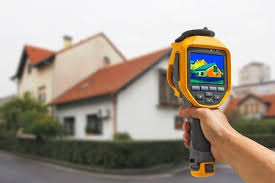
HOW TO BUILD INSULATION FOR THE HOME?
HOW TO BUILD INSULATION FOR THE HOME?
your home is not properly insulated and insulated, it can be very warm in the summer and cold in the winter. If you want to insulate your home to better control the temperature, there are easy ways to fix the problem. You can easily install insulation on open walls and in your attics. Many small spaces can also cause drafts and affect the temperature, so closing these areas can maintain the right temperature in your home. You can also put the insulation on finished walls by yourself, it can be more difficult and requires training.

Insulation Placement in Open Walls and Attic
See the minimum R-value for insulation in your area. The R value of insulation refers to the insulation strength or thermal resistance of the insulation you purchased. The higher the number for the R value, the more effective the insulation will be. The R value you need for insulation depends on the climate, the heating and cooling system you have and which part of the house you want to insulate. Check out an online manual or ask your worker at a building store to help determine what insulation is needed for your home.
You need insulation, usually R-13, to insulate walls.
Attics tend to need anywhere between R-30 and R-49 insulation.
Basements usually require a rating between R-11 and R-25.
If you want to insulate your floor, use R-12 to R-30 insulation depending on your climate zone.
Determine the area of the area where you are installing insulation and the stud distance. Measure the length and height of the wall and multiply them together to find the area of the wall. Next, measure the distance between 2 of the vertical studs on the wall so you know how wide your insulation should be. Stud distance is usually 41 or 61 cm) apart.
If you’re insulating an attic, measure the length and width of the attic. Instead of measuring the distance for wall studs, find the length between 2 of the base beams.

Choosing an Insulation Material
Choose mats or foam boards for your walls. Insulation sheets are thick fiberglass or natural fibers that come in rolls or pre-cut strips, and they work best for insulation walls, floors, and ceilings. Insulated foam boards are large panels that work best for foundation walls, floors, and ceilings. Choose the insulation with the R-value your home needs and check the packaging to find out how much space a single piece takes up so you can get enough space for the entire area you are insulating.
You can buy insulation from home improvement stores or online.
Get insulation with vapor barriers on one side to prevent moisture from getting through the insulation and getting trapped in your walls.
Wear long sleeves, gloves, and face protection before isolating. Most insulation is made of glass fiber, which can cause irritation on contact. Before you start, wear pants and a long-sleeved shirt to cover your skin as much as possible. Then wear work gloves, goggles that completely cover your eyes, and a face mask so you don’t breathe in any fiberglass particles.
Cut the insulation with a utility knife so it can match the height of your walls. Open the insulation so the moisture vapor faces up and measure the length you need with a tape measure. Place a straight edge at the top of the insulation and press it down to compress the foam. Push the utility knife blade into the insulator and carefully pull it towards you to slide it through. [5]
You can also use an insulating knife to cut the insulation. You can purchase insulating knives from your local hardware store.
You can also cut foam boards with a utility knife.
Press the insulations between the studs to ensure a tight fit. Direct the insulation into the space between the studs so the vapor barrier faces the interior of your home. Gently push the insulation into the space between the studs without squeezing the foam, otherwise it will not be effective. Make sure that the front of the insulation is flush with the front of the studs when you complete the installation.
Compressed insulation will not operate at its full thermal resistance.
If there is an electrical box or a jig in the wall, cut the insulation so that it fits tightly around it.
Tip: When installing insulation in the loft, place the vapor barrier face down, otherwise it will not be effective.
Staple the sides of the studs to keep the insulation in place. Grab the edge of the insulation or moisture barrier and hold tightly to the edge of the wall stud. Staple the staple along every 6 inches (15 cm) of stud in the wall. Repeat the process on the other side of the insulation so it is securely in place.
Some seals are labeled “compression fit” and do not need to be stapled.
You can also staple the insulation in front of the wall stud, but it may affect the fit of the drywall.

Covering Insulation Common Problem Areas
Insulate doors and windows to prevent heat losses. Air wraps around your doors and windows and looks for a place to escape. Look for knitted fabrics with adhesive backing and cut to the height you need for the seam of your door or window. Remove the back of the airbag and press it into place to secure.
You can purchase natural leather at your local home improvement store.
You can also purchase to remove and install the nails or screws on the side of the door frame.
Add sealant around the gaps in your floor and walls. There are small cracks or gaps in the corners between your floor and walls that can cause heat loss. Roll out a tube of silicone sealant and squeeze a small line into the corners of the floor to fill the gap. Smooth the silicone with your fingertip or a sealant scraper and press further into the gap to make it adhere better.
You can use felt in the same way to fill the gap.
Place door sweeps on exterior doors to keep air from getting in. Door sweeps cover the space between your floor and the bottom of the door to prevent air blowing under the floor. If you get a door sweep with an adhesive backing, simply cut it to the width of your door, peel off the back and attach it to the base. Otherwise, you may need to nail it to the door with the hardware provided.
You can buy door sweepers from your local hardware store.
Place thick curtains in front of the windows to prevent heat loss. When you leave your windows exposed, they can transfer cold air into your home. Close thick, dark curtains in front of your windows and keep them closed when you want to keep your home warm. The curtains prevent the cold air from getting in any further, so it doesn’t affect the temperature of your home.
Tip: Leave your curtains open when it’s sunny so the sunlight naturally warms your room so you don’t need to use a lot of energy to heat it.
Cover hard floors with rugs or carpets so they stay warm. Hard floors such as tile, laminate or wood can absorb heat and make your home less efficient. Place rugs, rugs or blankets to cover exposed flooring to conserve heat in your home. Choose a rug or rug that fits the rest of your room and install it to cover as much of the floor as possible.

Uninsulated floors can cause 10% of your home’s heat loss.
Install double glazed windows to prevent air leakage. Single-glazed windows only have 1 piece of glass, making it easier for cold air to flow in and hot air to expel. Double-glazed windows have a second piece of glass and cannot pass between the windows of cold and hot air. Check the windows in your home to see if they are single panes and contact a window specialist to have them replaced for you.
If you can’t change your windows, you can also get clear plastic window film sticking to the frame to prevent heat from escaping.

Insulation of Existing Walls
Consider hiring a contractor to install insulation in finished walls. Installing the insulation in finished walls by yourself can be tricky as you have to cut your existing drywall. There are also special equipment that you have to rent if you want to do it yourself. If you don’t feel comfortable cutting your walls, find a insulation service near you and ask for a quote to find out how much it will cost.
Inject the expanding foam insulation into your wall for the most effective action. Expanding foam increases in size when you inject it into walls to perfectly seal the areas between wall studs. Buy or rent an injection foam machine and use disposable coveralls with goggles and face mask to protect yourself. Drill a 1.3 cm hole in the top of your wall and thread the machine’s hose through it. Turn the machine on to spread the foam between the studs. Keep working in your room between each stud.
Injection foam usually requires a contractor to install safely, but you can rent a machine from hardware stores to do it yourself.
To inject the foam, you can drill holes on the outside or through the inner walls.
If you want to be minimally invasive, blow out the loose-fill insulation. Rent a blower machine from a hardware store with enough loose-fill insulation for your home. Drill enough holes in your wall for the ventilator’s hose between each stud. Feed loose fill insulation into the machine and insert the hose into the holes. Turn on the machine to blow the loose filler onto your walls until it’s tightly packed.
Loose fill insulation is made from small pieces of glass fiber or flame retardant cellulose material that settle on your walls for insulation.
Loose fill insulation can settle and compress over time, so it may not be effective as it ages.
To install the fiberglass insulation rolls, remove the existing drywall. Use a drywall saw or utility knife to cut walls you already have and remove them completely. Get rolls of fiberglass insulation with vapor barrier so you’ll have enough to insulate the room. Press the insulation against your wall so that it fits snugly and is flush with the studs. Staple the insulation in place before installing new drywall.
Tear down your existing drywall only if you can’t use loose-fill or expanding foam insulation.
